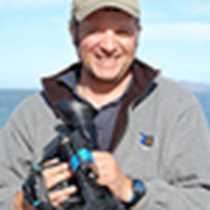We started our day with a pre-breakfast outing on Espumilla beach, situated on the island of Santiago. After a wet landing, we walked into the incense tree forest where several species of Darwin finches were spotted. Some of us even saw a Galápagos hawk near the beach that was eating a sea turtle hatchling. We learned so much about the endemic flora of the archipelago and were so delighted to hike on the island where Darwin had spent nine days during his time in Galapagos.
Some of us chose to go kayaking instead of hiking, and we sure had an amazing experience. Baby sea lions swam around us, some other were sleeping on the rocks—but the highlight of our morning was to see a couple of young Galápagos hawks chasing the baby fur seals (truly sea lions) back and forth just playing with them.
After breakfast, some of us went snorkeling and saw some white tip reef sharks and a large variety of tropical fish. The red rocky cliffs have created odd looking geological features that provide shade and shelter for the Galápagos fur seals. This was an outstanding snorkeling outing, quite a remarkable place.
After lunch, we navigated to Egas Port, a place named after a fellow called Hector Egas who established a salt mining facility on the cliffs of this calm bay. As soon as we landed, we saw the remains of the facilities of the salt miners. Our hike started with a walk along the basaltic lava and tuff formations that lay along the coastline. It was low tide and many offspring of marine animals were seen in the tide pools. Several marine iguanas were basking in the sun, some just coming out of the ocean after a nice meal of green algae. The old lava tubes on this island have already collapsed, creating natural lava pools known as “the grottos”; this is a perfect habitat for the Galápagos fur seals and some other small shore birds that feed on the small crustaceans that grown in the intertidal area.
We ended our day with an amazing rescue—we found a young Galápagos sea lion caught and wrapped in a piece of fishing net. Our naturalists together were able to take the net off its neck and free the now happy animal. A happy ending for the sea lion and an extraordinary sunset on our way back to the National Geographic Islander.









